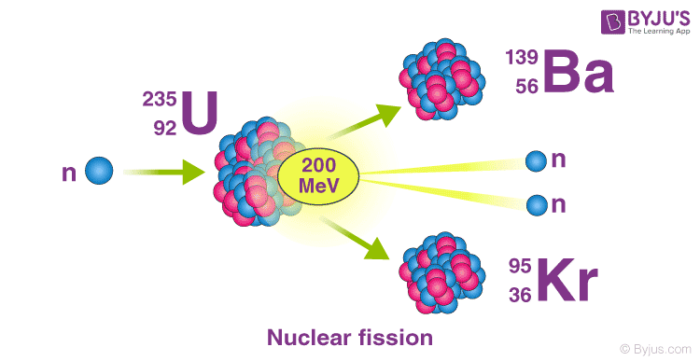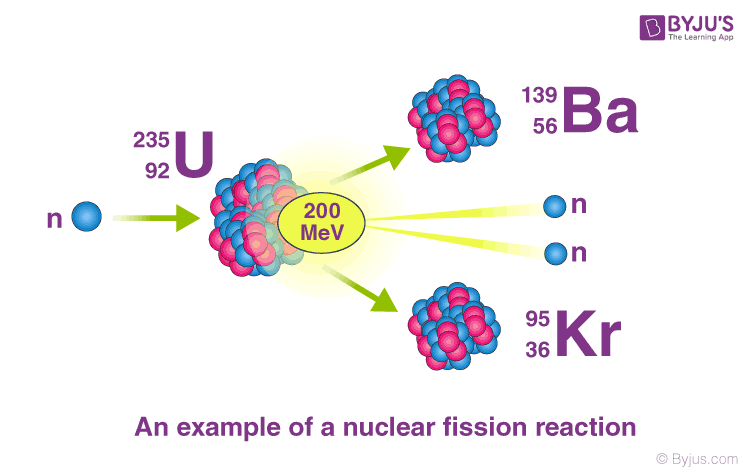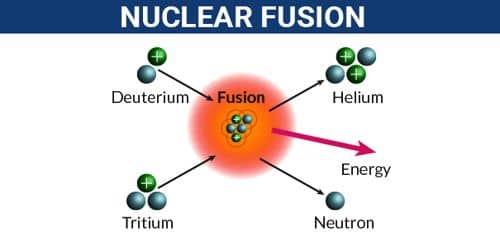- The fusion reaction
- Methods of achieving fusion energy
A nuclear reaction is considered to be the process in which two atomic nuclei or subatomic particles interact to produce one or more new particles or gamma rays. Thus, a nuclear reaction must cause a transformation of at least one nuclide to another.
- 1942: UChicago’s race to the first nuclear reaction. Scholars discuss the scientists at the University of Chicago who, on Dec. 2, 1942, achieved the first self-sustained nuclear chain reaction—as well as the implications of the historic experiment.
- Changes of nuclei that result in changes in their atomic numbers, mass numbers, or energy states are nuclear reactions. To describe a nuclear reaction, we use an equation that identifies the nuclides involved in the reaction, their mass numbers and atomic numbers, and the other particles involved in the reaction.
- For a discussion of the characteristics of direct (fast) and compound (massive energy sharing) nuclear reactions. Direct reactions: Reactions in which nuclei make glancing contact and then separate immediately. Projectile may exchange some energy and / or angular momentum, or have one or more nucleons transferred to it or removed from it.
- Nuclear reactions differ from other chemical reactions in that they involve changing the structure of the nucleus. Types of nuclear reactions include alpha decay, beta decay and gamma decay. Often particles such as electrons, neutrons, or protons are emitted during nuclear reactions.
Our editors will review what you’ve submitted and determine whether to revise the article.
Join Britannica's Publishing Partner Program and our community of experts to gain a global audience for your work! Robert W. ConnNuclear fusion, process by which nuclear reactions between light elements form heavier elements (up to iron). In cases where the interacting nuclei belong to elements with low atomic numbers (e.g., hydrogen [atomic number 1] or its isotopes deuterium and tritium), substantial amounts of energy are released. The vast energy potential of nuclear fusion was first exploited in thermonuclear weapons, or hydrogen bombs, which were developed in the decade immediately following World War II. For a detailed history of this development, seenuclear weapon. Meanwhile, the potential peaceful applications of nuclear fusion, especially in view of the essentially limitless supply of fusion fuel on Earth, have encouraged an immense effort to harness this process for the production of power. For more detailed information on this effort, seefusion reactor.


This article focuses on the physics of the fusion reaction and on the principles of achieving sustained energy-producing fusion reactions.
The fusion reaction

Fusion reactions constitute the fundamental energy source of stars, including the Sun. The evolution of stars can be viewed as a passage through various stages as thermonuclear reactions and nucleosynthesis cause compositional changes over long time spans. Hydrogen (H) “burning” initiates the fusion energy source of stars and leads to the formation of helium (He). Generation of fusion energy for practical use also relies on fusion reactions between the lightest elements that burn to form helium. In fact, the heavy isotopes of hydrogen—deuterium (D) and tritium (T)—react more efficiently with each other, and, when they do undergo fusion, they yield more energy per reaction than do two hydrogen nuclei. (The hydrogen nucleus consists of a single proton. The deuterium nucleus has one proton and one neutron, while tritium has one proton and two neutrons.)
Fusion reactions between light elements, like fission reactions that split heavy elements, release energy because of a key feature of nuclear matter called the binding energy, which can be released through fusion or fission. The binding energy of the nucleus is a measure of the efficiency with which its constituent nucleons are bound together. Take, for example, an element with Z protons and N neutrons in its nucleus. The element’s atomic weightA is Z + N, and its atomic number is Z. The binding energy B is the energy associated with the mass difference between the Z protons and N neutrons considered separately and the nucleons bound together (Z + N) in a nucleus of mass M. The formula is B = (Zmp + Nmn − M)c2, where mp and mn are the proton and neutron masses and c is the speed of light. It has been determined experimentally that the binding energy per nucleon is a maximum of about 1.4 10−12joule at an atomic mass number of approximately 60—that is, approximately the atomic mass number of iron. Accordingly, the fusion of elements lighter than iron or the splitting of heavier ones generally leads to a net release of energy.

Nuclear Reaction Equation
Two types of fusion reactions
Fusion reactions are of two basic types: (1) those that preserve the number of protons and neutrons and (2) those that involve a conversion between protons and neutrons. Reactions of the first type are most important for practical fusion energy production, whereas those of the second type are crucial to the initiation of star burning. An arbitrary element is indicated by the notation AZX, where Z is the charge of the nucleus and A is the atomic weight. An important fusion reaction for practical energy generation is that between deuterium and tritium (the D-T fusion reaction). It produces helium (He) and a neutron (n) and is written D + T → He + n.
To the left of the arrow (before the reaction) there are two protons and three neutrons. The same is true on the right.
The other reaction, that which initiates star burning, involves the fusion of two hydrogen nuclei to form deuterium (the H-H fusion reaction):H + H → D + β + + ν, where β + represents a positron and ν stands for a neutrino. Before the reaction there are two hydrogen nuclei (that is, two protons). Afterward there are one proton and one neutron (bound together as the nucleus of deuterium) plus a positron and a neutrino (produced as a consequence of the conversion of one proton to a neutron).
How Do Nuclear Reactors Work
Both of these fusion reactions are exoergic and so yield energy. The German-born physicist Hans Bethe proposed in the 1930s that the H-H fusion reaction could occur with a net release of energy and provide, along with subsequent reactions, the fundamental energy source sustaining the stars. However, practical energy generation requires the D-T reaction for two reasons: first, the rate of reactions between deuterium and tritium is much higher than that between protons; second, the net energy release from the D-T reaction is 40 times greater than that from the H-H reaction.
Nuclear Reactions Worksheet Answer Key
- key people
- related topics
